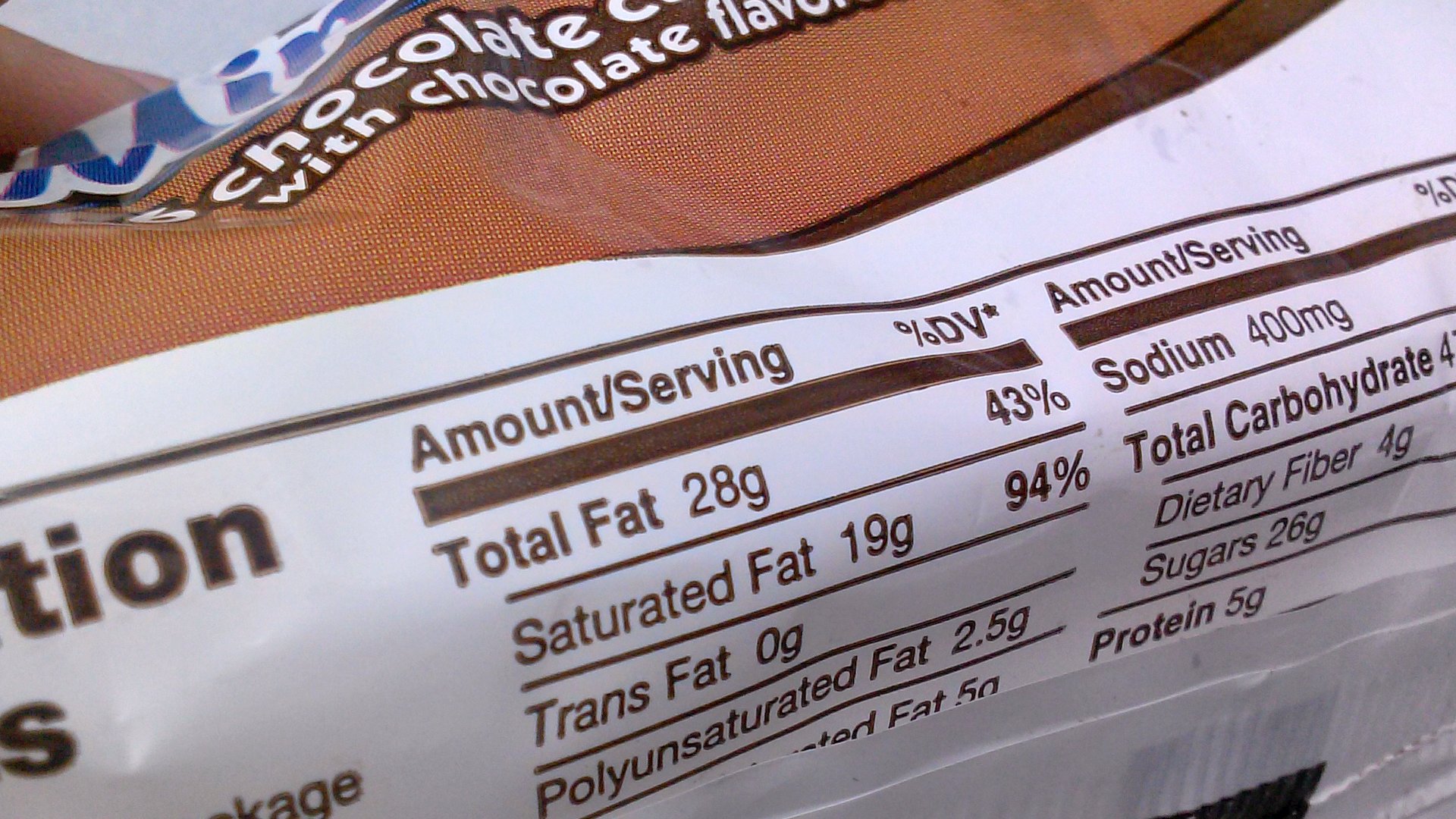On our regular visit to the supermarket, we pass by aisles and aisles of packaged foods before we can even reach the whole foods or vegetable sections. In our already hectic lives, even the most mindful eaters amongst us will reach out and pick a few pre-packaged foods. With more consumers becoming health conscious, food marketers have learnt new tricks to convince people to buy highly processed products. They add health claims to front labels, which are often misleading, to influence your buying decisions.
Not all prepackaged foods are bad for you. But to be able to distinguish between the good and bad ones, it is essential that you learn to read and interpret the labels on those packages. The truth lies in flipping the package.
Assess the Nutritional Label
1. Look at serving information.
Start with looking at the serving size under Nutritional facts. It could be listed as number of servings per container / packet or weight in gms/ml. A single serving size reflects the amount that people typically eat or drink. This is not a recommended serving size. Check the net weight of the package. This is the total amount of product in the package. Looking at the serving size and net weight will give you an idea of how many servings are there in a packet. The nutritional value below is generally based on one serving/ 100 gms/ 100 ml.
Lets take the example below of a pack of cornflakes and its nutritional chart as an example. Column A is the information provided on the packet, while column B and C are derived values for the resp. weights mentioned in the columns.
The net weight of the packet is 84gms. The serving size mentioned in 30 gms. But nutritional information provided is per 100gm ie 3.33 times the serving size mentioned. If you intend to eat only one serving, you need to know the nutritional values per 30 gm as in column B. If you decide to eat the entire packet, the nutritional values will be for 84 gms as in column C.
(*) Cornflakes (Net wt. 84gms)
| A Nutritional Values / Serving size: 30g %RDA | B | C | ||||
| Per 100g | Per 30g | Per 30 gm | Per 84 gm | |||
| Energy (kcal) | 388 | 5.83 | 116.5 | 323 | ||
| Carbohydrate (g) Total sugar (g) Added Sugar (g) Dietary fibre (g) | 88.4 | – | 26.5 | 73.6 | ||
| 7.8 | 2 | 2.34 | 6.5 | |||
| 5.39 | – | 1.61 | 4.491 | |||
| 2.86 | – | 0.85 | 2.38 | |||
| Protein (g) | 6.8 | – | 2.04 | 5.67 | ||
| Total fat (g) Saturated fat (g) Trans fat (g) | 0.79 | 0.35 | 0.24 | 0.66 | ||
| 0.14 | 0.18 | 0.04 | 0.11 | |||
| 0 | – | 0 | 0 | |||
| Cholesterol (mg) | 0 | – | 0 | 0 | ||
| Sodium (mg) | 885.88 | 13.9 | 266 | 738.2 | ||
| Iron (mg) | 2.04 | – | 0.62 | 1.7 | ||
I understand that this can get confusing. In fact, many people look at the nutritional value chart on the back of a packet and think the values mentioned are for the entire package (net weight). Hence it is of utmost importance to determine for what volume is the nutritional value mentioned.
2. Check the calorie count
The recommended daily calorie intake for women is 1800-2000 calories/day and it is 2,200-2,500 for men. This may vary depending on your age, weight, height and your daily physical activity. While calorie count is just part of the picture when it comes to reading nutritional labels, it can help you determine your calorie intake when you consume a serving/packet of packaged foods.
Referring to the example chart above (*), if you consume the whole packet of corn flakes (net wt 84gms, calories 323) with a glass of whole milk (61 calories), you consume 384 calories, which is about 1/5th of your daily calorie intake.
3. Keep an eye out for Unhealthy fats
Not all fats are bad for you. When reading nutritional labels, focus on the amount of saturated fats and transfats instead of total fats. Increased saturated fat consumption can increase your total cholesterol (LDL and HDL). Trans fats raise LDL (bad cholesterol) and reduces HDL (good cholesterol). It is also known to slow down your metabolism. Look for foods with 0 gms of trans fat. However beware of this disturbing factoid – If a product contains less than 1 % trans fat, it can be labelled as a zero trans fat product. When a nutritional label lists 0gm transfat and has ‘hydrogenated oil’ in its ingredient list, it means the food contains some trans fat. These trace amounts can add up, if you are eating multiple servings a day. Hydrogenated oils are used to increase and preserve shelf life of packaged foods. In 2015 the Food and Drug Administration (FDA)Trusted Source said that partially hydrogenated oil is not safe, and removing it from food could prevent thousands of heart attacks each year.
4. Limit sodium intake
The amount of sodium per serving is listed in milligrams (mg). Check the ingredient list for words like sodium, salt and soda. The total sodium shown on the Nutrition Values label includes the sodium from salt, and the sodium from any other sodium-containing ingredient in a product. This includes ingredients like sodium nitrate, sodium citrate, monosodium glutamate (MSG) or sodium benzoate.
The American Heart Association recommends no more than 2,300 mg a day (about one teaspoon) and an ideal limit of less than 1,500 mg per day for most adults, especially for those with high blood pressure. Excess sodium intake is associated with an increased risk of high blood pressure, heart disease, and stroke. It can also cause calcium losses, some of which may be pulled from bone.
5. Check carb content and avoid added sugars
While carbohydrates are often demonised these days, the truth is they are a great source of energy and found abundantly in whole foods. Complex carbohydrates like the ones found in whole fibrous foods like fruits and vegetables are infinitely better for you than simple carbs. Simple carbohydrates like refined flour or refined sugar are commonly found in packaged foods.
When you look at a nutritional label, you will notice the amount of sugar listed in grams. There is no recommended daily value. Most of us will have difficulty visualising a gram of sugar. To get an idea of how much sugar is in the container, start by dividing the total gms of added sugar by 4. This gives you the amount in teaspoons. For example. A single serving of fruit juice can contain upto 20gms of sugar. This is equivalent to 5 teaspoons of sugar in a single serving. As you learn to read this information, you may realise that you are consuming way more sugar than you add to your daily tea.
6. Get enough beneficial nutrients
Dietary fibre, Vitamin D, calcium, iron and potassium are ingredients on the nutritional label that are identified as nutrients to get more of. A diet high in dietary fiber can increase the frequency of bowel movements, lower blood glucose and cholesterol levels, and reduce calorie intake. The recommended daily intake of fibre is about 25-30gms/day. Diets higher in vitamin D, calcium, iron, and potassium can reduce the risk of developing osteoporosis, anemia, and high blood pressure.
7. The percentage of Recommended Daily Allowance (%RDA)
The RDA is the daily amount of a nutrient you’d need to consume to meet the requirements of almost all (97%-98%) healthy individuals in every demographic group. This is based off a 2000 calorie diet. RDA values are a rough measure of what a sedentary person needs to maintain a baseline level of nutrition and avoid deficiency diseases. But it is not perfect. You may need more or less of established RDA depending on your health and activity level. The %RDA is the percentage of each nutrient in a serving of the food. It can tell you how much a nutrient in a serving of a food contributes to a total daily diet. For example, if a serving of a certain food provides 40% of the daily RDA for Vitamin C, the %RDA for Vit C in that food is 40%. So, if you see that a product has a %RDA for Vit C of 10% and another has 40%, it is obvious that the second product will meet your body’s Vit C requirements easier since it provides a higher percentage of your body’s daily Vit C needs with each serving. %RDA can tell you if a serving of food is low or high in a nutrient. A general guide to check %RDA – A %RDA of 5% or less means the food item is low in that nutrient and 20% or more means it is high in that nutrient.
Interpreting the ingredient list
Once you have successfully assessed the nutritional label, its time to read the list of ingredients.
Shorter the ingredient list the better
All ingredients must be listed in the descending order by weight, including water. So the first ingredient on the list makes up the bulk of the product by weight and the last ingredient the least. As a general rule of thumb, try to go for products whose first 3 listed items are unprocessed and recognisable ingredients. If you can’t pronounce or don’t recognise the ingredient on the list, you can use a chemical dictionary to find out what the ingredient is.
Another rule you can follow is to avoid products with more than 5 listed ingredients. Lengthy ingredients lists are generally a sign of unnecessary extras like additives and preservatives. You can learn more about additives, preservatives and their effects here
Look out for Hidden Sugars
Sugar is the general name given to short-chain carbs that give your food the sweet taste. However sugar can masquerade in many forms and under different names. There are more than 60 names for added sugar.
Some ways to identify that an ingredient is a sugar:
- it has syrup (examples: corn syrup, rice syrup)
- the word ends in “ose” (examples: fructose, sucrose, maltose, dextrose)
- “sugar” is in the name (examples: raw sugar, cane sugar, brown sugar, confectionary sugar)
Some more examples of hidden sugars are galactose, glucose, lactose, levulose, beet sugar, corn sugar, corn sweetener, high fructose corn syrup, invert sugar, isomalt, maltodextrins, maple sugar, sorghum or turbinado sugar. You might even find more than one listed. These are all just variations on high-calorie, low-nutrient, added sugar.
Sugar alcohols also frequently feature in ingredient lists. There are many types but some of the most common ones are sorbitol, mannitol, maltitol and xylitol. Sugar alcohols provide a sweet taste with fewer calories per gram than sugar, and are commonly used in place of sugar and often in combination with artificial sweeteners. They can have less of an impact on your blood glucose levels, but some common side effects are abdominal bloating, gas and diarrhoea. Foods that contain the sugar alcohols sorbitol or mannitol must include a warning on their label that states “excess consumption may have a laxative effect.”
A food sweetened with “sugar alcohols” can say “0 grams sugar” on the nutritional label, but if the product uses the term ‘sugar-free’ or ‘no added sugar,’ the manufacturer must declare the sugar alcohol content separately.
Remember that ingredients can change anytime
Even if you have been buying a product for years, keep in mind that things change. Check labels every once in a while when you are out shopping. A decade back Matodextrin was rarely seen in ingredient lists, but now it is listed in most packaged foods. Sugar content has been increasing steadily in almost all prepacked food. Regular checks can help you understand what you are really putting into your body.
Other important Food labels to look at
1. Color coding
India has a large population of people that consume vegetarian diets. Hence in 2011, it became mandatory for all processed food products to be labelled to indicate whether products are vegetarian (green) or non-vegetarian (brown).
Non-Vegetarian – Every package of food that contain ingredients including food additives, and processing aids of animal origin have to depict a symbol and color code, to indicate that the product is a Non-Vegetarian Product. In the recently released 2020 Labeling and Display Regulations, FSSAI has changed the symbol of non vegetarian food from a brown circle to a brown triangle to help colour blind people distinguish it from the green circle denoting vegetarian food.
The symbol consists of a brown color-filled triangle inside a square with a brown outline having the diameter and sides not less than the minimum size specified.

If an article of food contains egg only as Non-Vegetarian ingredient, the manufacturer, or packer or seller may give a declaration to this effect in addition to the said symbol.
Vegetarian – Every package of food that contain ingredients including food additives, and processing aids of plant origin have to depict a symbol and color code, to indicate that the product is a Vegetarian Product.

The symbol consists of a green color-filled circle inside a square with a green outline having the diameter and sides not less than the minimum size specified.
2. Food Allergen Declaration
If you have food allergies, you should read labels to avoid the foods you are allergic to.
The FSSAI has recently made it mandatory to declare eight major ingredients that trigger food allergies. Any food that contains one of the eight allergens viz., Cereals containing gluten, Crustacean, Milk, Egg, Fish, Peanuts and tree nuts, Soybeans and sulphites in concentration of 10mg/kg or more as an ingredient will have an allergen declaration on the label. Raw commodities do not need an allergen declaration. You may also see advisory statements such as “may contain (allergen) or “produced in a facility that also uses (allergen).” Such statements are not required by law and can be used to address unavoidable cross contamination.
3. Date Marking
Date marking is a crucial part of any food label describing the shelf life of a product. It is essential to know the meaning of different terms that manufacturers use on food labels. Dates do not just indicate how long the product can be stored, but also indicates the safety and quality of the food product. The FSSAI has made it mandatory that dates be declared using the DD/MM/YY marking for products with a short shelf life upto 3 month. If the shelf life of the product is more than 3 months, the month and year will be mentioned. Special conditions for storage of food should also be mentioned apart from expiry or use by date.
Date of manufacture means the date on which the food becomes the product as described.
Date of packaging means the date on which the food is placed in the container in which it will be ultimately sold.
Use – by date or Expiry date means the date which signifies the end of the estimated period under any stated storage conditions. After this date the food will probably not have the quality and safety attributes normally expected by the consumers and the food cannot be sold. Certain products like fresh fruit and vegetables, wines, alcohol, confectioneries, food grade salt, sugar do not need an expiry date.
Best before means the date which signifies the end of the period under any stated storage conditions during which the food shall remain fully marketable and shall retain any specific qualities for which express claims have been made. Beyond that date, the food may still be perfectly safe to consume, though its quality may have diminished. However the food shall not be sold if at any stage the product becomes unsafe.
You will find ”Date of manufacture” or “packaging” and “Expiry/Use by” in one place on the food label.
When you start learning to read nutritional labels, it can seem cumbersome and confusing. But once you get a hang of it, it will become second nature to you. Start with flipping a package and understanding the labels on at least one packaged food on a weekly basis. Think of reading nutritional labels as a form of dietary self-defense. It puts you back in control of your food choices and allows you to make informed decisions about what you are really putting into your body.





